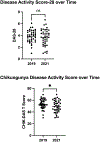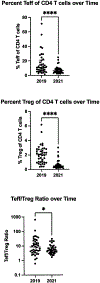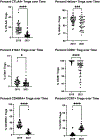The Natural History of Post-Chikungunya Viral Arthritis Disease Activity and T-cell Immunology: A Cohort Study
- PMID: 38873035
- PMCID: PMC11172407
- DOI: 10.33696/immunology.6.191
The Natural History of Post-Chikungunya Viral Arthritis Disease Activity and T-cell Immunology: A Cohort Study
Abstract
Background: Chikungunya virus (CHIKV) is an alphavirus spread by mosquitos that causes arthralgias and arthritis that may last for years. The objective of this study was to describe the arthritis progression and T cell immunology over a two-year period.
Methods: A cohort of 40 cases of serologically confirmed CHIKV from Magdalena and Atlántico, Colombia were followed in 2019 and again in 2021. Arthritis disease severity, disability, pain, stiffness, physical function, mobility, fatigue, anxiety, sleep disturbances and depression were assessed. Serum cytokines and T-cell subsets were measured and tested for change. Correlations within each of the 2 time periods for laboratory parameters were also examined.
Results: Although, arthritis disease severity, as measured by the Disease Activity Score-28 (DAS-28) did not change significantly over a two-year period, a new metric- the Chikungunya Disease Activity Score (CHIK-DAS)- was more sensitive to detect changes in disease severity than the Disease Activity Score-28 (DAS-28) and showed some improvement in average disease severity from moderate to mild over two years. Cases were characterized by moderate disability, pain, and stiffness with mild alterations of physical function, mobility, fatigue, anxiety, sleep disturbances and depression that did not change significantly over time. Small joints including the fingers and wrists were most affected without significant change over time. The percentage of effector T cells (Teffs) and regulatory T cells (Tregs) of CD4+ T cells both decreased over time. Teff percentages decreased more significantly resulting in a halving of the Teff/Treg ratio two years later. Furthermore, markers of Treg immunosuppressive function such as CTLA4, Helios, CD28, CD45RA and 41bb decreased over time. Cytokines did not change significantly over time.
Conclusions: The presented data suggest that arthritis persists almost seven years after chikungunya infection in some patients with waning Teff and Treg numbers and activation markers over time. Treg activation may be a promising therapeutic target for further investigation.
Keywords: Arthritis; Arthritis disease severity; Chikungunya virus; Disability; Pain; Stiffness; T-cell populations.
Conflict of interest statement
Conflicts of Interest AYC reports consulting for Valneva. GSF reports consulting for Eli Lilly. Other authors report no commercial interest or conflicts of interest in relation to this work.
Figures




References
-
- With rising cases, experts discuss Chikungunya spread in the Americas - PAHO/WFIO ∣ Pan American Health Organization [Internet]. [cited 2024 Mar 6]. Available from: https://www.paho.org/en/news/4-5-2023-rising-cases-experts-discuss-chiku...
-
- Pan American Health Organization. Chikungunya - PAHO/WHO ∣ Pan American Health Organization [Internet]. [cited 2023 Apr 27]. Available from: https://www.paho.org/en/topics/chikungunya
Grants and funding
LinkOut - more resources
Full Text Sources
Research Materials
